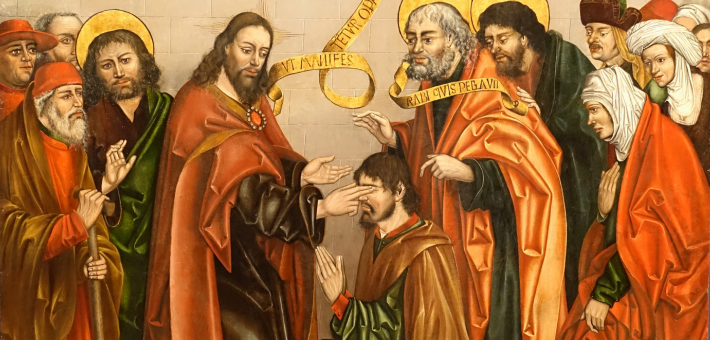Commentary on Mark 10:46-52
Pick up any commentary on the Gospel of Mark that came out in the last 20 years or so and turn to the section on the Bartimaeus story in 10:46–52. More likely than not, the commentator will tell you that Bartimaeus is a model disciple and a paragon of faith. This interpretation has become popular for good reasons. Whereas the rich man in the same chapter does not want to let go of his possessions (10:22), Bartimaeus throws off his cloak (10:50), which must have been one of the few things or perhaps the only thing he had as a beggar.
Bartimaeus has been compared also with the apostles. Commentators have explained how Bartimaeus exemplifies discipleship, unlike the apostles, who utterly fail. At the end of the story, Bartimaeus follows Jesus on the way to Jerusalem (10:52). “Following Jesus” and “on the way” are recurring expressions (literary motifs) in Mark that tell us about the theme of discipleship. The apostles are called to “follow” (1:17) Jesus. While they follow him in the literal sense, they fail to understand or trust him. Jesus seems frustrated when he says to them in chapter 4, “Have you still no faith?” (4:40).
Fast-forward to chapter 9, when Jesus gives the second passion prediction (9:31), and the disciples “did not understand what he was saying” (9:32). They then argue “on the way” (9:33, 34) about who is the greatest among them. While “on the way” (10:32) to Jerusalem, Jesus gives the third and last passion prediction. James and John come to Jesus, and he asks, “What is it you want me to do for you?” (10:36). They ask for the right and left seats next to Jesus (10:37). Their request shows how miserably they fail to understand his identity, mission, and teaching.
Jesus asks the same question of Bartimaeus: “What do you want me to do for you?” (10:52). Jesus grants Bartimaeus’s request and recognizes his faith. Eventually, as noted above, Bartimaeus follows Jesus “on the way” (10:52) to Jerusalem, where Jesus is crucified.
I wonder if some commentators have interpreted Bartimaeus in completely positive ways because of the comparison. They comment that Bartimaeus, who is physically blind, truly “sees” who Jesus is, as he calls him “Son of David”—that is, the royal Messiah. Does Bartimaeus truly see Jesus’ messianic identity and mission? I doubt that.
Jesus is the royal Messiah in Mark. One of the passages that illustrates this point is located right after the Bartimaeus story: that Jesus chooses to enter Jerusalem riding on a donkey is an unmistakable allusion to Zechariah 9:9. But the royal Messiah is not here to reestablish the kingdom of David now.
Mark’s Jesus explains his messiahship using the title “Son of Man.” The Son of Man must undergo rejection, suffering, and death now (8:31; 9:31; 10:33–34). The Son of Man will come with power and glory in the future (13:21–27). Who in the Gospel of Mark really understands the twofold nature of Jesus’ messiahship and the implied timeline? No one.
Non-disciples know less than the disciples. People regard Jesus as John the Baptizer, Elijah, or a prophet (8:28). These three figures do not accurately or fully capture Jesus’ identity and mission. Peter correctly identifies Jesus as the Messiah (8:29), even though he and other apostles do not fully understand when and how Jesus’ messianic mission is to be fulfilled.
In Mark, non-disciples cannot fully know Jesus’ identity and mission for two reasons. The first reason is theological: Jesus states that the secret of the kingdom of God is given only to the disciples (4:11). In accordance with the prophecy of Isaiah that Jesus quotes (4:12; see also Isaiah 6:9–10), outsiders cannot comprehend what they hear. The second reason is that Jesus does not disclose his messianic identity publicly (for example, 8:30). Only the disciples get to hear the three passion predictions. A relatively long account of the glorious Son of Man is given only to four apostles (13:3, 21–27).
A rare exception is a brief, public statement of Jesus regarding the coming of the Son of Man in glory (8:38). But here Jesus speaks as if the glorious Son of Man is someone other than Jesus himself, which makes it difficult for the crowd to understand the statement.1 Thus, for theological and practical reasons, non-disciples cannot fully understand Jesus’ messiahship in Mark.
There is no compelling reason to regard Bartimaeus as an exception. Some commentators point out that in antiquity, blind people were thought to have special insights or a prophetic power. This view of blindness by itself does not settle our interpretation of Bartimaeus because there were other ancient views of blindness (for example, as a divine punishment). Moreover, blind seers were usually figures of authority who gave counsel or oracles. They are portrayed as ones with power to help others, not as ones who desperately ask for help.
No one in Mark is perfect, and I find it oddly consoling. Jesus asks, “What do you want me to do for you?” People ask for healing, exorcism, power, political liberation, or other things. Jesus might sigh deeply (see also 8:12), as no one really understands him. Sometimes I feel people are using Jesus. But I know I am no different. If my loved ones needed medical miracles, I would ask for help desperately. I hope Jesus will understand me, even if I don’t fully understand him.
Notes
- Scholars have usually taken Mark 8:38 as evidence that the historical Jesus distinguished himself from the Son of Man who will come with power. This view implies that the author of Mark was not careful enough to edit the preexisting saying of Jesus. I think the seemingly odd wording in 8:38 perfectly serves the Markan theme that the crowds cannot understand what they hear. In this regard, 8:38 functions like Jesus’ parables in Mark, whose true or full meanings are hidden from people.


October 27, 2024